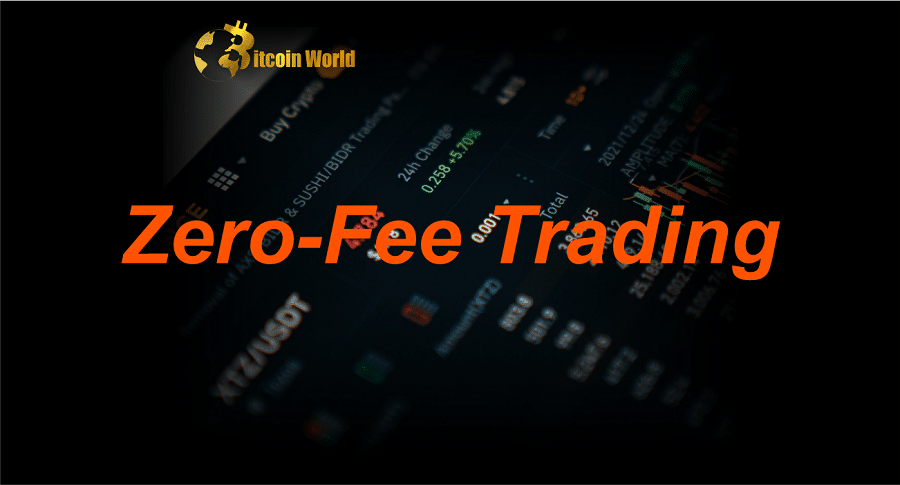The crypto world is buzzing with news out of Binance, the world’s leading cryptocurrency exchange by trading volume. It seems the era of zero-fee Bitcoin (BTC) trading on the platform is coming to a close, at least for most pairs. After a nine-month run of attracting users with the allure of commission-free trades, Binance has decided to scale back this offering. What does this mean for Binance’s dominance and the broader crypto landscape? Let’s dive into the details.
Why Did Binance End Zero-Fee Trading?
On Wednesday, Binance initiated a gradual rollback of its zero-fee trading program for a range of Bitcoin asset pairs. Interestingly, the zero-fee perk remains exclusively for the stablecoin TrueUSD (TUSD). This strategic move by Binance could signal a significant shift in the dynamics of centralized crypto exchanges. Could this be the beginning of the end of Binance’s unchallenged reign?
According to data from Kaiko, a cryptocurrency market data provider, zero-fee trading pairs have accounted for a staggering 60% of Binance’s total trading volume. That’s a huge chunk! So, why would Binance, which is often associated with intellectual property Techteryx and Archblock (formerly TrustToken), decide to potentially sacrifice such a large portion of its volume?
To understand this, we need to rewind a bit.
The Zero-Fee Strategy: A Market Share Grab
Remember the crypto market crash last summer? Exchanges were feeling the pinch with low trading volumes and dwindling profits. It was a tough time for everyone. That’s when Binance made a bold move. They launched zero-fee trading for select BTC pairs globally. It was a strategic masterstroke to attract users and boost trading activity.
Clara Medalie, the Head of Research at Kaiko, highlights just how effective this strategy was. In an email to Coindesk, Medalie pointed out that this zero-fee initiative propelled Binance’s market share from 50% in July to a whopping 72% when compared to the most liquid exchanges. That’s a massive leap in market dominance in a short period!
Here’s a quick look at the impact of zero-fee trading on Binance’s market share:
- July (Pre-Zero Fee): 50% Market Share (approx.)
- Post Zero-Fee Launch: 72% Market Share (approx.)
Essentially, zero-fee trading was a powerful tool for Binance to aggressively expand its market footprint.
The Unsustainability of Zero-Fee Trading
While zero-fee trading is a fantastic perk for users, it’s not a sustainable business model in the long run. As Medalie aptly put it, “Zero-fee trading is unsustainable in the long run, but it allowed Binance to quickly obtain a significant amount of market share.”
Think about it: exchanges need revenue to operate, innovate, and ensure platform stability. Transaction fees are a primary source of income for these platforms. Offering zero fees indefinitely would erode profitability and potentially compromise the long-term health of the exchange.
Medalie further suggests, “We could anticipate a short-term decline in market share without zero costs for the majority of BTC pairs.” This implies Binance is prepared for a potential dip in market share in exchange for a more sustainable revenue model.
TrueUSD (TUSD): Binance’s Stablecoin of Choice?
The decision to maintain zero-fee trading only for TrueUSD (TUSD) is particularly noteworthy. It comes at a time when Binance’s previous preferred stablecoin, Binance USD (BUSD), is facing regulatory headwinds.
Remember the New York Department of Financial Services (NYDFS) crackdown on Paxos, the issuer of BUSD? The NYDFS ordered Paxos to halt the issuance of BUSD last month, leading to a significant contraction in its supply. BUSD supply plummeted from $16 billion to $8 billion, a dramatic halving in a short period.
This regulatory pressure on BUSD has seemingly opened the door for TUSD to step into the limelight. According to Medalie, “TUSD appears to have been chosen by the exchange as a potential successor.”
TUSD’s Surging Market Cap
The numbers speak for themselves. After the announcement of BUSD‘s phaseout, TUSD experienced a remarkable surge in market capitalization. CoinGecko data reveals that TUSD‘s market cap more than doubled, reaching $2 billion. This growth underscores the market’s perception of TUSD as a potential beneficiary of BUSD‘s decline.
Here’s a table summarizing the key shifts:
| Stablecoin | Event | Impact |
|---|---|---|
| BUSD | NYDFS Order to Paxos | Supply Halved, Decline in Prominence |
| TUSD | Binance Zero-Fee Retention (BTC/TUSD), BUSD Issues | Market Cap Doubled, Rise in Prominence |
Who is Behind TrueUSD (TUSD)?
The story of TUSD has some interesting layers. The TUSD stablecoin’s intellectual property was acquired by Techteryx, described as a relatively unknown Asian investment firm. The stablecoin itself is managed by Archblock, previously known as TrustToken.
Adding another layer of intrigue, there have been reports suggesting that TUSD was initially created by Justin Sun, the founder of Tron and a well-known crypto billionaire. However, both Archblock and Justin Sun have refuted these claims. The exact origins of TUSD remain somewhat shrouded in mystery.
What’s Next for Binance and TUSD?
Binance’s decision to roll back zero-fee Bitcoin trading marks a significant strategic adjustment. While it might lead to a temporary decrease in market share, it’s a move towards a more sustainable business model. Simultaneously, the spotlight is firmly on TrueUSD (TUSD), which appears poised to become Binance’s stablecoin champion in the wake of BUSD‘s regulatory challenges.
Will TUSD truly become the dominant stablecoin on Binance? Will Binance maintain its overall market leadership despite the reduction in zero-fee trading? These are key questions to watch as the crypto landscape continues to evolve. One thing is clear: the dynamics of centralized crypto exchanges are constantly shifting, and Binance’s latest move is a prime example of this ongoing evolution.
Disclaimer: The information provided is not trading advice, Bitcoinworld.co.in holds no liability for any investments made based on the information provided on this page. We strongly recommend independent research and/or consultation with a qualified professional before making any investment decisions.


